Caverns of Mars
| Caverns of Mars | |
|---|---|
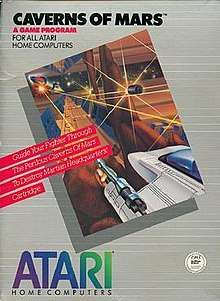 | |
| Publisher(s) | Atari Program Exchange |
| Programmer(s) | Greg Christensen[1] |
| Platform(s) | Atari 8-bit |
| Release | 1981 |
| Genre(s) | Vertically scrolling shooter |
| Mode(s) | single player |
Caverns of Mars is a vertically scrolling shooter for the Atari 8-bit computers, programmed by Greg Christensen and published by the Atari Program Exchange (APX) in 1981.[1] It became the best selling APX title of all-time and was moved into Atari, Inc.'s official product line, first on diskette and later on cartridge.
The game is essentially a vertical-scrolling version of the arcade game Scramble, with the twist that the player must re-trace their steps through the map to finish the levels.
History
Greg Christensen, a high-school senior, purchased an Atari 800 in 1981, and created Caverns in "little more than a month and a half"—the first significant program he wrote in 6502 assembly language.[2] Fred Thorlin, one of APX's few employees at the time and later the director of APX between 1982 and 1984, recalls Caverns arriving at APX:
| “ | It was received by APX in the morning mail. I saw it at 10:30. We showed it to the president of the company just after lunch. It was not a tough decision for him. Legal got in touch with Greg Christensen in short order. The young man, I think he was a community college freshman, suddenly had a bunch of money inflicted upon him. I was never certain whether he benefited from that in the long run or not.[3] | ” |
Two months after sending it to APX, Christensen received his first royalty check for $18,000, and a phone call from an Atari executive who praised the game. Caverns eventually won the 1981 APX game contest, winning another $3,000, and in December 1982, Atari told Christensen he might receive up to $100,000 in royalties.[4]
Atari licensed the game in early 1982 for distribution in the main Atari catalog, distributing it on diskette.[5] This was the first such example of an APX to Atari move, among very few examples in total. When asked to collaborate on a cartridge-based port, Christensen declined, having started college.[6]
Gameplay
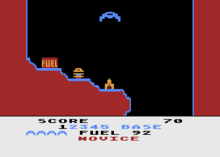
Caverns of Mars is a vertically scrolling shoot 'em up similar in concept and visual style to the 1981 arcade game Scramble.[7] Christensen changed the orientation of the caverns from Scramble, having the player fly down into them as opposed to sideways through them. For technical reasons, vertical scrolling is somewhat easier than horizontal to implement on the Atari platform. Unlike Scramble, the targets generally did not move relative to the map.
Using a joystick, the player controls a ship descending into the tunnels of Mars, firing at targets along the way. The player's spacecraft features two cannons, positioned on either side of the craft, firing downwards. The player needs to avoid hitting the cavern walls, while shooting targets of opportunity along the way. Fuel tanks can be shot to add 5 points of fuel, and the craft is destroyed if it runs out.
There are several different sections of the map, with easier skill levels removing the more difficult sections from the areas through which the player has to fly. The easiest skill level has only three sections, the hardest has six. On any skill level the last section of the map is a reactor, which the player lands on and thereby sets to explode. The player then has to reverse course and fly up and out of the caverns to escape before the reactor explodes.
Legacy
Sequels
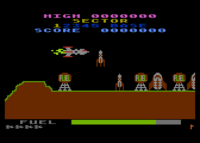
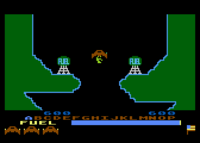
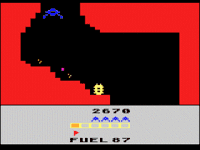
Christensen followed Caverns in 1981 with a lesser-known sequel, known originally as Caverns of Mars II. This version is very similar to Scramble, scrolling sideways and featuring rockets that launched upwards from the ground. The game was completed in 1981, but for reasons that are not clear, it was not released. It would not be published until several years later by Antic Software, renamed to Mars Mission II.[8]
Combining the vertical orientation of the original Caverns with the improved graphics of Caverns II, Phobos was released through APX in 1982, although there were other minor modifications as well.[9][10] The levels were broken down into sub-levels with letters as names; after being killed the action restarts at the top of the sub-level, as opposed to the top of the whole level. The system is similar to the one used in Moon Patrol. The game also added a pause feature.
Re-releases
In 1983, Atari released Caverns of Mars on a cartridge (RX8021).[11][12] In 2005, a version of Caverns of Mars was included on the Atari Flashback 2 classic game console.[13]
Clones
Datamost's Cavern Creatures (1983) for the Apple II [14] and homebrew game Conquest of Mars (2006) for the Atari 2600 are both direct clones.
Reception
Computer Gaming World called Caverns of Mars "delightful ... addictive and excellently paced". It noted the age of the author and stated that the game "has all the look, feel, and play of a 'professional' program".[15] Softline liked the game's use of checkpoints after losing a life, and concluded "This game is great; you'll find it difficult to pull yourself away".[16] Compute! called Caverns of Mars's graphics "impressive … an excellent use of the Atari's graphics capabilities," noting that the game takes advantage of a little-used mode allowing four colors per character.[17] A Creative Computing reviewer opened with "Four minutes later. I was hooked. Four hours later, my wife dragged me away." and concluded by noting that "The Caverns of Mars has that indefinable "something" that makes it arcade-quality".[6] The Addison-Wesley Book of Atari Software 1984 gave the game an overall B+ rating, calling it "fast-paced and addictive" and "great fun ... a must for any dedicated arcade game player".[18] Electronic Fun gave it a 3.5 out of 5 rating, praising the action and pointing out only a few minor flaws.[19]
Caverns of Mars received a Certificate of Merit in the category of "Best Science Fiction/Fantasy Computer Game" at the 4th annual Arkie Awards,[20]:32
Phobos reception
Softline stated that Phobos might disappoint Caverns of Mars players, stating that it was "a reinvention of the wheel" and too easy for them. The magazine noted some improvements, such as a pause button and multiple skill levels, but advised that "Mars veterans should wait".[21] The Addition-Wesley Book of Atari Software 1984 gave the game an overall B rating, stating that "whether it is a better game than the original is debatable" and concluding that "it is a good choice for the dedicated arcade game player".[18]
References
- 1 2 Hague, James. "The Giant List of Classic Game Programmers".
- ↑ "Caverns of Mars User's Guide" (PDF). Atari Mania. Atari, Inc.
- ↑ Savetz, Kevin (April 2000). "Fred Thorlin: The Big Boss at Atari Program Exchange". AtariArchives.org.
- ↑ Dale Archibald, "Programming for Dollars", Video Games, December 1982
- ↑ "Caverns of Mars", The Atari Connection, Spring 1982, p. 11
- 1 2 "Caverns of Mars", The Creative Atari, 1983
- ↑ Overview of Caverns of Mars at allgame.com
- ↑ "Mars Mission II", Atarimania
- ↑ "Phobos", Allgame
- ↑ Keita Iida, "PHOBOS", Atari HQ
- ↑ Charlotte Thai, "Back to Basics", How they Got Game
- ↑ Matt Barton and Bill Loguidice, "A History of Gaming Platforms: Atari 8-Bit Computers", Gamasutra
- ↑ "Atari Flashback 2 specs", cnet
- ↑ Shore, Howard A. (Jan–Feb 1984). "Cavern Creatures". Softline. pp. 49–50. Retrieved 29 July 2014.
- ↑ Anderson, John J. (May–June 1982). "Atari Arcade". Computer Gaming World. p. 18.
- ↑ Bang, Derrick (May 1982). "Caverns of Mars". Softline. pp. 14–15. Retrieved 15 July 2014.
- ↑ Brannan, Charles (July 1982). "Caverns of Mars". Compute! (review). p. 183. Retrieved 30 October 2013.
- 1 2 Stanton, Jeffrey; Wells, Robert P.; Rochowansky, Sandra; Mellid, Michael, eds. (1984). The Addison-Wesley Book of Atari Software. Addison-Wesley. pp. 89–90. ISBN 0-201-16454-X.
- ↑ Gerson, Phil (April 1983). "Caverns of Mars" (PDF). Electronic Fun: 64.
- ↑ Kunkel, Bill; Katz, Arnie (March 1983). "Arcade Alley: The Best Computer Games". Video. Reese Communications. 6 (12): 32–33. ISSN 0147-8907.
- ↑ Bang, Derrick (May–Jun 1983). "Phobos". Computer Gaming World. p. 44. Retrieved 28 July 2014.
External links
- Caverns of Mars 1982 Atari, Inc. version at Atari Mania
- Caverns of Mars, play-through on Novice settings